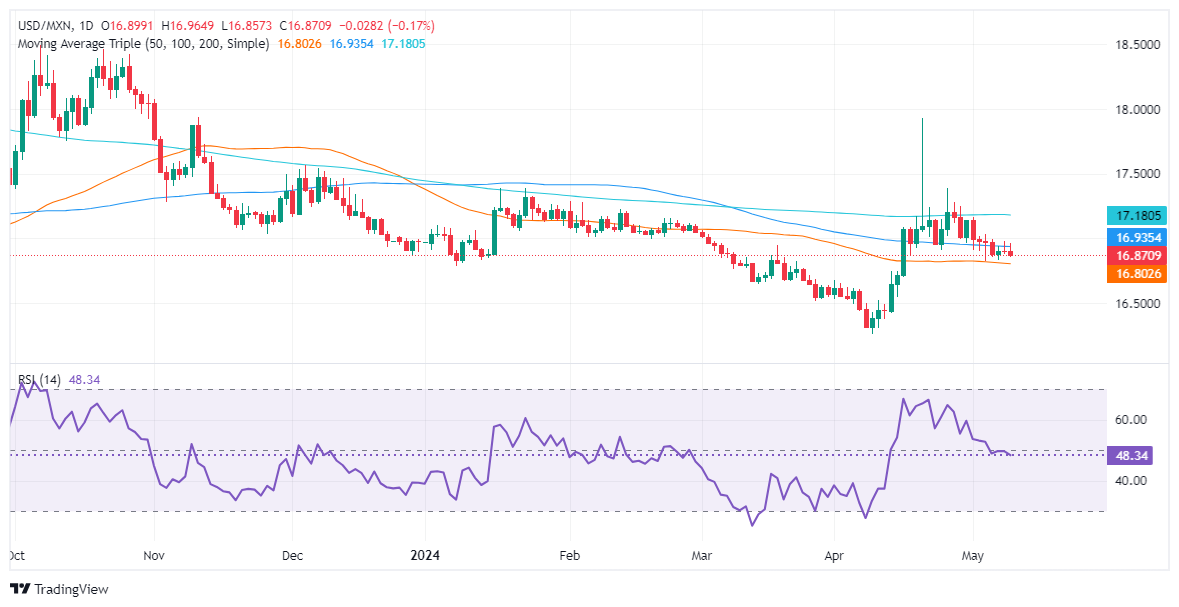- Mexican Peso strengthens as the USD/MXN drops 0.21%, following April’s hot inflation report
- Consumer Price Index data shows prices remain above Banxico’s target range, hinting it may hold rates at 11.00%.
- USD/MXN traders’ eye upcoming decisions from Banxico and its updates to economic projections.
The Mexican Peso appreciated against the US Dollar after the latest inflation data increasing the likelihood that the Bank of Mexico (Banxico) will keep rates unchanged. Headline figures on a monthly and annual basis exceeded forecasts, but underlying measures edged slightly lower. The USD/MXN trades at 16.86, down 0.21%.
Mexico’s economic docket revealed that the Consumer Price Index (CPI) for April showed that prices remain above Banxico’s 3% plus or minus 1% goal, which would likely prevent the Mexican central bank from continuing to ease policy.
Looking ahead, Banxico, under the leadership of Governor Victoria Rodriguez Ceja, is expected to keep rates unchanged at 11.00% by most analysts as inflation reaccelerated last month. However, it’s crucial to note that Mexico’s economy has shown signs of weakness, largely due to the economic slowdown in the United States (US). This factor could significantly influence the future of the Mexican Peso.
Therefore, USD/MXN traders should watch Banxico’s Governing Council’s decision and the update on economic projections.
Across the border, the US jobs market continued to show signs of cooling, with the number of Americans filling out unemployment benefits crushing estimates. Later, San Francisco Fed President Mary Daly will cross the newswires.
Daily digest market movers: Inflation in Mexico rises ahead of Banxico’s decision
- Mexican Core CPI in April increased by 0.21% MoM, below the expected 0.24% and significantly lower than the previous month’s increase of 0.44%. Meanwhile, headline CPI moderated to 0.20%, slightly above the forecast of 0.19% but below the prior month’s 0.29%.
- On an annual basis, underlying inflation rose by 4.37%, below estimates of 4.40% and March’s 4.55%. Headline inflation ticked up to 4.65%, up from 4.42%, exceeding forecasts of 4.63%.
- Most bank analysts predict that Banxico will keep interest rates steady with a unanimous decision expected from the Governing Council. However, future meetings are anticipated to be more contentious, potentially leading to divided votes. This expectation arises from comments by two Deputy Governors, Irene Espinosa and Jonathan Heath, who have stated that inflation is still elevated, necessitating that interest rates stay put.
- US Department of Labor revealed that Initial Jobless Claims for the week ending May 4 increased by 231K, above estimates of 210K, up from the previous week’s 209K.
- US labor market continues to cool. April’s Nonfarm Payrolls and the release of the latest unemployment claims data can put pressure on Fed officials, who acknowledged that risks to achieving its dual mandate on employment and inflation “moved toward better balance over the past year.”
- Data from the futures market see odds for a quarter percentage point Fed rate cut in September at 86%, versus 55% ahead of last week’s FOMC decision.
Technical analysis: Mexican Peso gains traction as USD/MXN tumbles below 16.90
The USD/MXN remains biased to the downside, showcasinging the Peso’s strength as sellers remain in charge. Momentum depicted by the Relative Strength Index (RSI) in bearish territory hints that the exotic pair can be testing the 50-day Simple Moving Average (SMA) at 16.79, which is the immediate support level in the short term.
Once cleared, the USD/MXN would test the 2023 low of 16.62, followed by the current year-to-date low of 16.25.
On the other hand, if buyers claim the 100-day SMA at 16.93, that could sponsor a leg up to the 17.00 psychological level. A breach of the latter would expose the 200-day SMA at 17.17, followed by the January 23 swing high of 17.38 and the year-to-date high of 17.92.
Banxico FAQs
The Bank of Mexico, also known as Banxico, is the country’s central bank. Its mission is to preserve the value of Mexico’s currency, the Mexican Peso (MXN), and to set the monetary policy. To this end, its main objective is to maintain low and stable inflation within target levels – at or close to its target of 3%, the midpoint in a tolerance band of between 2% and 4%.
The main tool of the Banxico to guide monetary policy is by setting interest rates. When inflation is above target, the bank will attempt to tame it by raising rates, making it more expensive for households and businesses to borrow money and thus cooling the economy. Higher interest rates are generally positive for the Mexican Peso (MXN) as they lead to higher yields, making the country a more attractive place for investors. On the contrary, lower interest rates tend to weaken MXN. The rate differential with the USD, or how the Banxico is expected to set interest rates compared with the US Federal Reserve (Fed), is a key factor.
Banxico meets eight times a year, and its monetary policy is greatly influenced by decisions of the US Federal Reserve (Fed). Therefore, the central bank’s decision-making committee usually gathers a week after the Fed. In doing so, Banxico reacts and sometimes anticipates monetary policy measures set by the Federal Reserve. For example, after the Covid-19 pandemic, before the Fed raised rates, Banxico did it first in an attempt to diminish the chances of a substantial depreciation of the Mexican Peso (MXN) and to prevent capital outflows that could destabilize the country.
